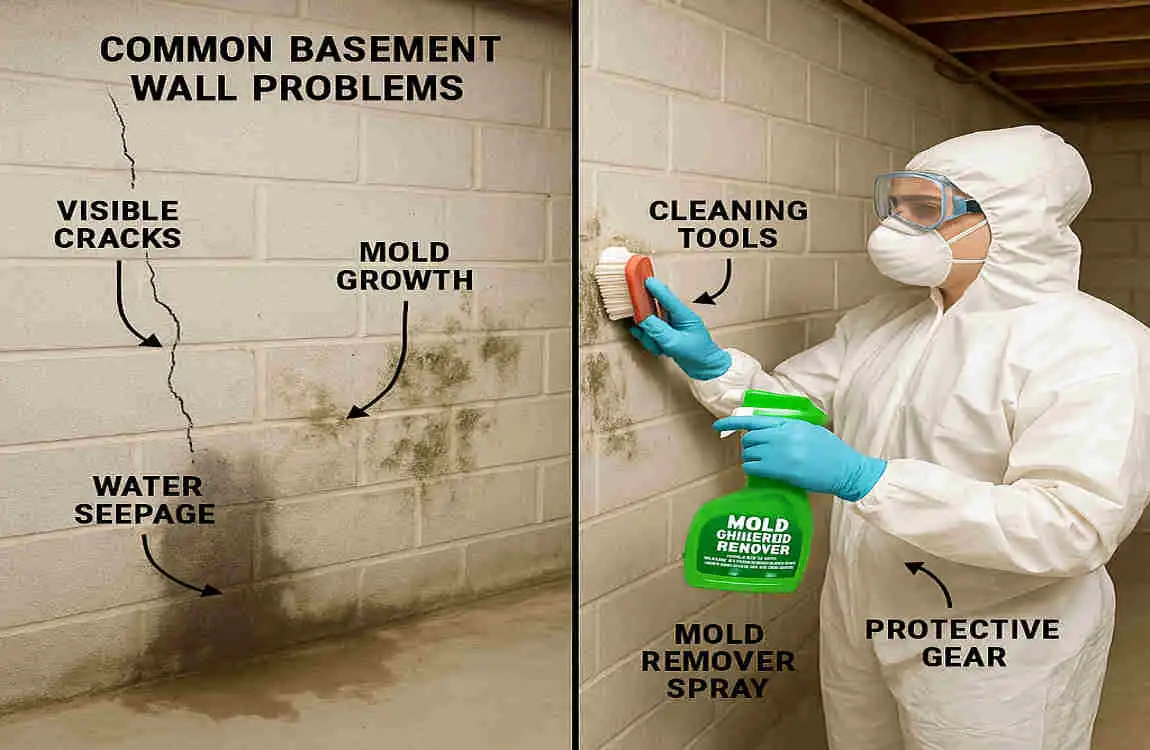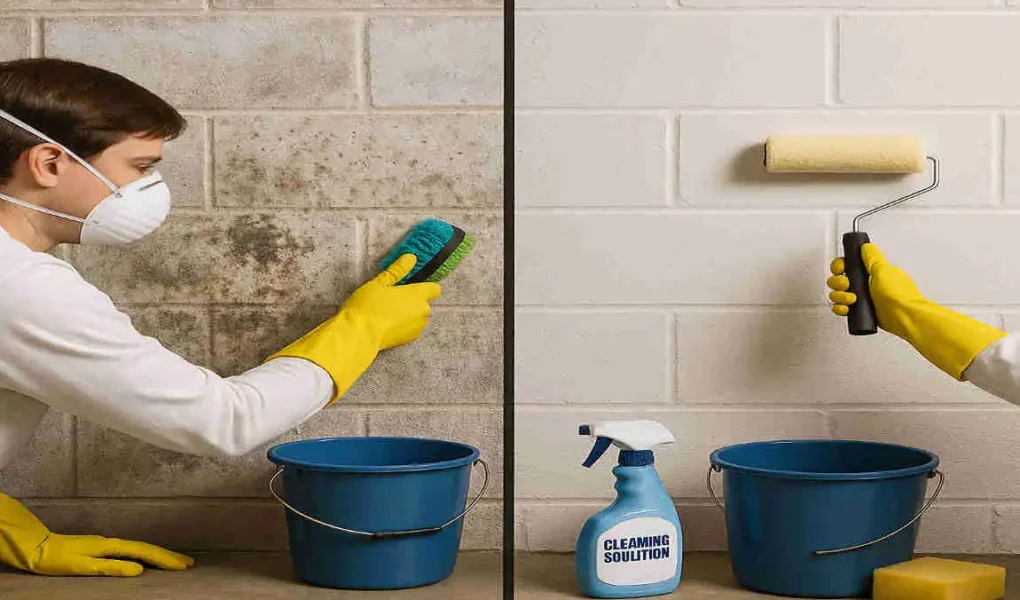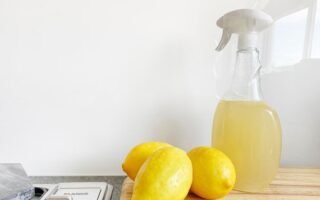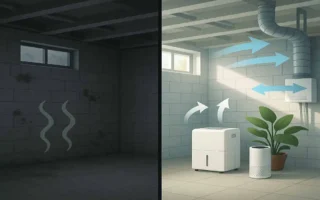Basements are often one of the most overlooked parts of a house, yet they play a crucial role in maintaining the structural integrity and overall health of your home. As homeowners, we often ignore the condition of our basement walls until problems like mold, mildew, or water damage become too severe to ignore.
Cleaning your basement walls isn’t just about appearances—it’s about protecting your home. A house clean and well-maintained basement helps prevent issues such as mold growth, structural damage, and poor indoor air quality.
Understanding Basement Wall Problems

Cleaning basement walls starts with understanding the potential problems that can arise from neglect. Let’s break this down further.
Importance of Basement Wall Maintenance
Your basement walls are more than just structural supports—they’re the foundation of your home. Over time, dirt, grime, and contaminants can accumulate, weakening the walls and potentially inviting unwanted issues such as mold or water damage. If left unaddressed, these issues can lead to:
- Weakening of your home’s foundation: Excess moisture and mold growth can erode materials and compromise the structural integrity of your home.
- Health risks for your family: Mold and mildew release spores into the air, which can cause allergies, asthma, or other respiratory issues.
- Increased repair costs: Neglected basement walls can lead to cracks, leaks, and costly professional repairs.
Keeping your basement walls clean is the first line of defense against these problems.
Common Contaminants on Basement Walls
Basement walls are magnets for a variety of contaminants. Here are some of the most common culprits:
- Dirt and Dust: Basements often collect dirt due to limited ventilation and heavy foot traffic.
- Efflorescence: This refers to white, powdery salt deposits that form when moisture seeps through the walls.
- Mold and Mildew: These thrive in damp, dark environments and can quickly spread if not addressed.
- Water Stains and Mineral Deposits: These are telltale signs of moisture problems.
Understanding these issues will help you select the most effective cleaning methods and prevent future buildup.
Preparing to Clean Basement Walls
Before diving into the cleaning process, it’s important to prepare properly. This ensures a safe and efficient experience.
Safety Precautions
Cleaning basement walls often involves handling chemicals and dealing with contaminants, such as mold. To protect yourself, follow these safety tips:
- Wear protective gear: Use gloves, goggles, and a mask to avoid exposure to dust, mold spores, or cleaning agents.
- Ensure proper ventilation: Open windows and use fans to improve airflow and reduce the risk of inhaling harmful fumes.
- Check for structural issues: Inspect your walls for cracks or damage before cleaning. If you notice significant problems, consult a professional before proceeding.
Tools and Materials Needed
Having the right tools and materials on hand makes the cleaning process much smoother. Here’s what you’ll need:
Tools Cleaning Agents
Scrub brushes (stiff-bristle), Mild detergent
Sponges and rags, Bleach solution (for mold)
Buckets of Vinegar and baking soda (natural alternative)
Spray bottles, Mold removers, or fungicides
Wet vacuum (optional)
Optional tools, such as a power washer or dehumidifier, can also be beneficial, depending on the level of contamination.
Step-by-Step Process on How to Clean Basement Walls

Now that you’re prepared, it’s time to get into the nitty-gritty. Follow these steps carefully for the best results.
Clear the Basement Walls
Begin by removing any furniture, decorations, or obstructions from the area near your basement walls. This will give you easy access to the entire surface. While you’re at it, inspect the walls for visible damage, mold growth, or water stains. If you notice deep cracks or persistent dampness, address these issues before proceeding with cleaning.
Dry Brush to Remove Loose Dirt and Debris
Use a stiff-bristle brush or broom to remove surface-level dirt, dust, and spider webs. This step is crucial because it prevents loose debris from interfering with the cleaning solution later on. Don’t skip this step—it will significantly enhance the effectiveness of the cleaning process.
Apply Cleaning Solution
Choose a cleaning solution based on the type of contaminants on your walls. For general cleaning, mix warm water with mild detergent.
- For mold or mildew: Use a bleach solution (1 cup of bleach per gallon of water) or a specialized mold remover.
- For natural cleaning: Mix equal parts vinegar and water, or create a paste using baking soda and water.
Spray or apply the solution to the walls using a sponge or cloth. Let it sit for 10–15 minutes to loosen dirt and stains.
Scrub the Walls Thoroughly
Using a scrub brush or sponge, work the cleaning solution into the walls. Focus on areas with visible stains, mold, or efflorescence. Use circular motions and apply extra pressure on stubborn spots. Be patient—this step takes time but is key to achieving a deep clean.
Rinse and Dry the Walls
Once you’ve scrubbed the walls, it’s time to rinse them off. Use clean water and a sponge or rag to remove any residue. For large areas, a wet vacuum can speed up the process.
After rinsing, ensure the walls are completely dry. Use fans, a dehumidifier, or towels to remove excess moisture. This step is crucial in preventing future mold growth.
Specialized Cleaning for Mold and Mildew
If your basement walls have mold or mildew, you’ll need to take extra precautions and employ specific techniques to address the problem effectively.
Identifying Mold vs. Mildew
Mold and mildew are often confused, but they have distinct characteristics:
- Mildew: Appears as a powdery, white, or gray substance on surfaces.
- Mold: Typically green, black, or brown with a fuzzy texture. Mold is more harmful and requires immediate attention.
Effective Mold Removal Techniques
For mold, use a bleach solution or a commercial mold remover. Apply the product directly to the affected area and scrub vigorously. Always wear protective gear to avoid inhaling spores.
If you prefer natural solutions, vinegar is highly effective at killing mold. Spray undiluted vinegar onto the moldy area, let it sit for an hour, and scrub it off.
Preventive Steps After Cleaning
To prevent mold and mildew from returning:
- Apply mold-resistant paint or sealant to your walls.
- Use a dehumidifier to maintain low humidity levels in your basement.
- Improve ventilation by installing exhaust fans or opening windows regularly to keep the air fresh and circulating.
Additional Tips for Long-Term Basement Wall Care
Once your walls are clean house, adopting a proactive maintenance routine can save you time and money in the long run.
Regular Cleaning Schedule Recommendations
The frequency of cleaning your basement walls depends on your home’s climate and usage. As a general rule:
- High-humidity areas: Clean every 3–6 months.
- Low-humidity areas: Clean annually.
Waterproofing and Sealing Basement Walls
Investing in waterproofing materials, such as sealants or epoxy coatings, can protect your walls from moisture and extend their lifespan. These products create a barrier that prevents water from seeping into the walls.
Monitoring for Structural Issues
Keep an eye out for cracks, water leaks, or persistent dampness. If you notice any of these issues, don’t hesitate to call a professional. Early intervention can prevent costly repairs later.




